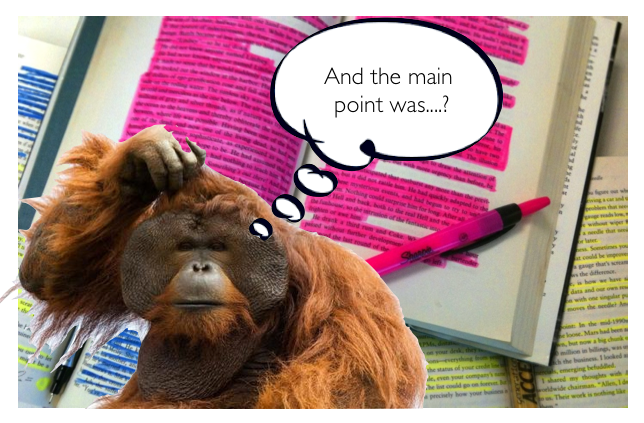
You understand the dangers of smoking, texting as you drive and walking down dark allies on your own at night. You know it’s foolish and potentially dangerous to engage in these behaviours. But perhaps you’re less aware of the dangers of highlighting (and underlining).
For most students, highlighting and underlining information feels so natural and normal that the suggestion it could be dangerous seems completely absurd.
But research studies show highlighting (as a study technique) is largely ineffective, especially if you go nuts and highlight every single sentence!
What’s the problem with highlighting?
Highlighting can give you an ‘illusion of competence’. When you highlight text you tend to think the information has transferred from the page into your brain when often it hasn’t.
Another problem with highlighting is that it draws your attention to specific concepts rather than encouraging you to think about the connections between different ideas.
But the biggest problem with highlighting is that it prevents you from using more effective study strategies. If you are busily highlighting ideas, chances are you’re not going to be creating visual notes or writing paraphrased notes in the margins.
No better than reading the material
Unless you’re incredibly disciplined, we all know how easy it is to get carried away with those glorious fluorescent colours.
As Dunlosky et al. (2013) explain the reason many of us enjoy highlighting so much as a study technique is because it is “simple to use, does not entail training, and does not require students to invest much time beyond what is already required for reading the material”.
But they also state:
“..most studies have shown no benefit of highlighting (as is typically used) over and above the benefit of simply reading”.
One of those studies was conducted by Fowler and Barker back in 1974. In this study that assessed the benefits of highlighting, students had to read articles about boredom and city life. The students were allocated to one of three groups:
1) Control group: they only read the articles (no highlighting allowed);
2) Active highlighting group: they could highlight information as much of the text as they liked; and
3) Passive highlighting group: they could read text that had already been highlighted by participants in group 2.
The students in each group studied the articles for one hour. One week later, the students took a multiple-choice test.
How did each of the groups go on the test?
Well, the highlighting groups (both active and passive) did no better than the control group. A pretty depressing result for highlighter junkies, eh?
But there’s more to this…
When the researchers looked at the results of the two highlighting groups (active and passive) in detail, the researchers saw the effects highlighting had on cognitive processing. Here’s what they found:
The active highlighting group performed better on test items that related to the text they had highlighted but they struggled with test questions that related to information they had not highlighted.
So what is a student to do?
After all, you can’t just go highlight everything, as that’s not effective at all.
Researchers suggest that highlighting is so ineffective that students would be better off ditching their highlighter pens for more effective study techniques.
But they also acknowledge this may difficult. Why?
Because students love their highlighter pens. They aren’t prepared to give them up so easily!
If this is indeed the case for you, it’s time to focus on exercising a little restraint with your highlighter pens.
Here’s the thing: The more text you highlight, the more problems you’re going to run into.
Remember, the whole point of highlighting is to make the text distinctive. To make important ideas stand out. If everything is highlighted you’ll be less likely to remember any of it.
The key thing is to look for the main ideas in a text and only highlight those. Some studies have found that restricting students to only highlighting one sentence per paragraph resulted in better retention of information that was underlined.
Final thoughts…
Personally, I believe variety is the key to keeping your studies interesting. I am a visual note taker, but sometimes (especially when I’m tired) I just can’t be bothered mind mapping. This is when I switch to disciplined highlighting and drawing little pictures and notes in the margins.
Students enter the danger/ineffective zone when they rely on highlighting as their number 1, go to study strategy. You want to arm yourself with a diverse range of strategies and be able to draw on each strategy depending on the type of work you need to do and your energy levels.
So if you’re someone who tends to rely a lot on your highlighter pens, maybe it’s time to give those pens a rest and test some other techniques such as mind mapping.
References
Dunlosky, J., Rawson, K. A., Marsh, E. J., Nathan, M. J., & Willingham, D. T. (2013). Improving students’ learning with effective learning techniques promising directions from cognitive and educational psychology. Psychological Science in the Public Interest, 14(1), 4-58.
Fowler, R. L., & Barker, A. S. (1974). Effectiveness of highlighting for retention of text material. Journal of Applied Psychology, 59, 358–364.
